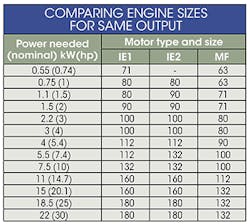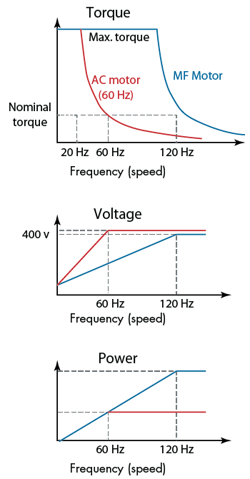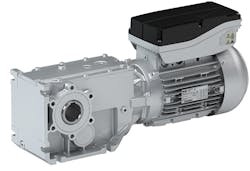This file type includes high resolution graphics and schematics when applicable.
Electric drives consume a tremendous amount of energy in most manufacturing facilities. Virtually every automated function in a given plant, from packaging and labeling to pick-and-place robots, relies on at least one electric drive. Therefore, engineers should consider energy requirements when specifying intelligent and integrated drives.
However, a host of factors determines a drive’s energy efficiency, and complicated methods for choosing “optimal” drives and other components for automation systems. To simplify drive selection, designers and engineers should take an analytical approach to mechanical needs and energy requirements. The following steps will ensure you end up with the right design, as well as “right-sized” motor drives and control components, for an ideal, energy-efficient drive system. (Also, see "What's the Difference Between a Motor and a Drive?")
Analyze and Compare Drives
Generally, a complete drive system includes mechanical and electrical/electronic components. The system’s total energy efficiency can be calculated, as can energy contribution to production costs and CO2 emissions. It is also possible to estimate potential energy and cost savings from using dc power recovery instead of a brake resistor. Another key factor in getting the most efficiency from a motor-drive system is to choose drive components precisely sized for a specific application. Naturally, over-dimensioning should be avoided and components should not be subjected to extreme overloads.
Meeting energy-efficiency goals begins with using design software to determine drive dimensions that will tailor the final system to application requirements. This can prevent the common problem of over-dimensioning motors, drive, and inverter controls.
There is also design software that simulate various scenarios, estimate the energy required, and make component recommendations. This same software can provide an energy audit that shows an application’s energy consumption, breaking it down by individual drive components. Seeing options lets engineers make side-by-side comparisons of mechanical concepts and drive components.
Flexibility of Efficient Drives
The proper drive can give engineers the design freedom to choose a right-sized motor that has equal or more output than larger, more costly, and less energy-efficient motors. A classic three-phase ac motor typically increases in size as energy efficiency improves. This can lead to space issues inside a machine, along with other adverse effects. For example, higher rotor inertias increase energy consumption when changing speeds.
For a common four-pole, three-phase ac motor, 120 Hz is the ideal operating frequency for the best mix of high output power, dynamic response, wide speed range, and a high level of efficiency. Multiple frequency motors also provide a wide speed range and a high degree of efficiency while reducing cost and energy usage. Many 120-Hz, multi-frequency, three-phase ac motors were developed with these goals in mind.
In Lenze’s motors, electrical windings are optimized to a rated frequency of 120 Hz, with a rated voltage of around 380 V ac for global flexibility and a rated speed of 3,500 rpm. These attributes increase both dynamic performance and productivity. Compact and highly efficient, these motors can be paired with a 96% efficient, two-stage bevel gearbox with a lightweight, aluminum housing and precision-honed, wear-free gear teeth.
For variable-speed applications, compact, 120-Hz, multi-frequency ac motors provide even more value, including space savings. Designed for tasks requiring variable setting ranges with minimal sizes, these 120-Hz geared motors exceed efficiency-class IE2 motors while delivering speed ranges of 24:1. By contrast, conventional motors offer adjustment ranges of only 3:1. Because these 120-Hz motors feature speed ranges much wider than those of conventional motors, they can be used on applications that require slow and fast speeds from a single motor, with constant torque throughout the setting range.
Ultimately, users look for reliability and availability. In automated warehouses, for example, high throughput, packing density, and energy efficiency minimize costs and increase flexibility. It’s possible for a single 120-Hz motor to provide all these benefits while serving a variety of applications. These compact, three-phase motors, for instance, enable energy-efficient drive solutions without costly design alterations.
Inverter-optimized, asynchronous versions of 120-Hz multi-frequency motors can be up to two frame sizes smaller than conventional IE2 motors while offering the same performance. In addition, because the motor is smaller, the rotor inertia is lower than standard ac motors. This results in short dynamic-response times, letting the motor go from 0 to 3,500 rpm in 500 msec.
New high-speed performance storage and retrieval units on the market can accelerate to high traveling speeds quickly inside warehouse bays. Energy-efficient drive and control technology ensures the necessary dynamic response. Using composites rather than steel construction can significantly lighten the load, thereby reducing the mass that needs to be driven, and enabling the use of smaller drive axes. And, reduced load for lower mass inertia and synchronous servo motors can lead to enormous acceleration rates in next-generation storage and retrieval units.
Efficiently Convert Energy
Excess, unused energy is the most costly energy. Many applications with electric drives require frequent acceleration and braking. Therefore, proper use of braking can improve efficiency. When accelerating or lifting, electric energy gets converted into kinetic energy, some of which is recovered when braking or lowering. Recovered energy is often converted into unused heat via brake resistors. In some applications, it is worth capturing this energy to exchange between drive systems or for short-term storage in a capacitor or power recovery to the mains. Regenerative power tends to be most useful and cost-effective at outputs greater than 5 kW, but energy savings are still only nominal.
Mechanical power generated by the electric drive must be oriented toward the automated task to effectively use energy in all drive processes. More than a third of newly installed three-phase ac motors are designed for frequency-inverter operation using electronic controls. The advantages of these three-phase motors become even more apparent in drive packages with gearboxes and frequency inverters. Combining a decentralized inverter drive with a high-efficiency, geared ac motor makes the connection straightforward and energy-efficient, and eliminates the need for a control cabinet.
Beyond traditional cabinet-mounting topology, compact, decentralized inverter units can minimize cabinet space requirements. Decentralized drives, featuring low overall height when mounted directly on a motor, can be coupled with gearing to reach efficiency levels of 92 to 98%.
Calculate Energy Savings
Class IE2 efficiency standards have driven many developments in inverter design that have led to higher levels of energy efficiency without sacrificing performance. Many decentralized inverters, for example, adapt the motor magnetizing current to actual process needs, thus reducing losses, particularly in partial load operation. This, in turn, improves efficiency and reduces energy consumption by up to 30%.
Most electrical and electronics engineers agree that IE3 efficiency standards will be met with permanent-magnet synchronous motors. Decentralized drives can run these motors without any feedback. This feature also allows open loop control in some positioning applications. Eliminating the cost of feedback in such applications becomes a plus for these drives.
To put this all into perspective, consider a food distribution center that uses over 10,000 geared motors and drives. In such an operation, it only takes a quick calculation of the total cost attributable to motors to highlight the importance of right-sizing.
Suppose all the center’s motors were 2-kW versions and operated fully loaded with an IE2 efficiency of 84%. For each motor, the calculated power usage would be 2,000/0.84 = 2,381 W. In 24 hr, the energy consumption would to 57 kWh. Assuming $0.10 per kWh, a 24-hr period would cost $5.70 per motor. By right-sizing and deploying a mechatronic solution that provides even a modest 1% improvement in efficiency, this center could realize a savings $570 daily.
The best drive systems are those that will make life easier and lead to added value for end users. To determine which is the best motor for your application, you need to understand the machine and relevant technologies it needs to get the job done most efficiently. Therefore, when developing automation systems, work with companies experienced at making components and complete systems. This ensures all the hardware and software will work together whether in a multi-component machine, a single piece of equipment, or a one-million-square-foot factory.
This file type includes high resolution graphics and schematics when applicable.





